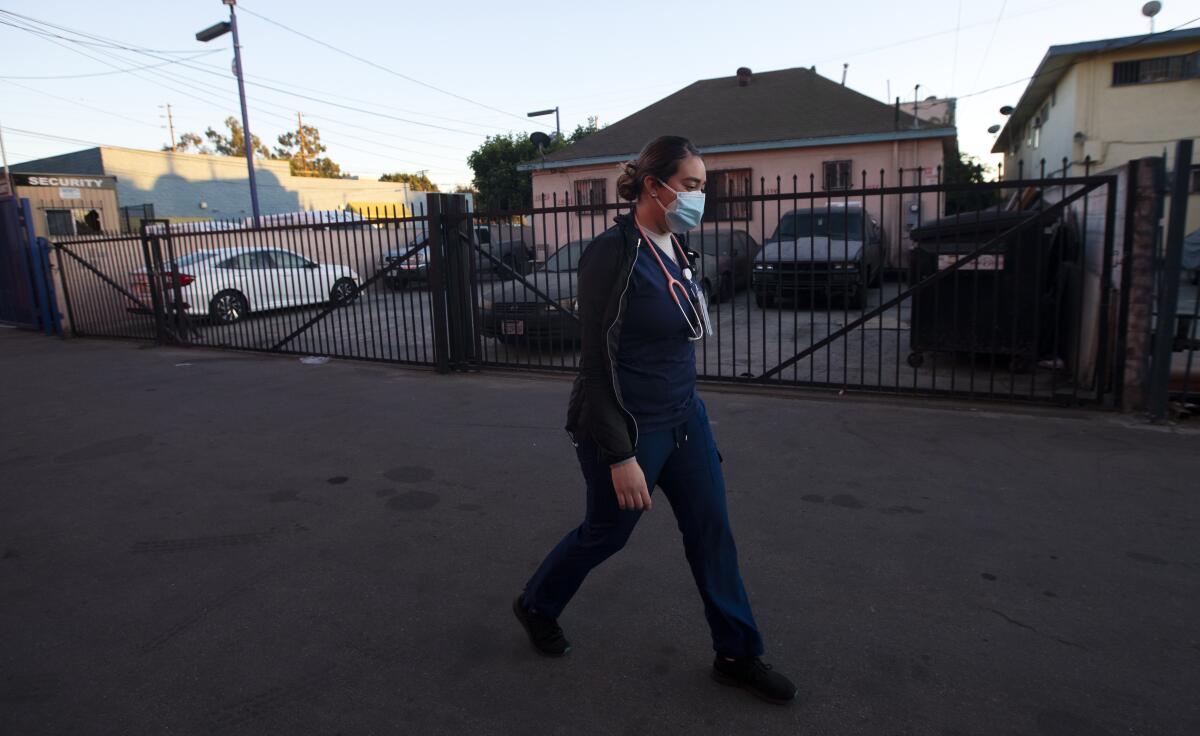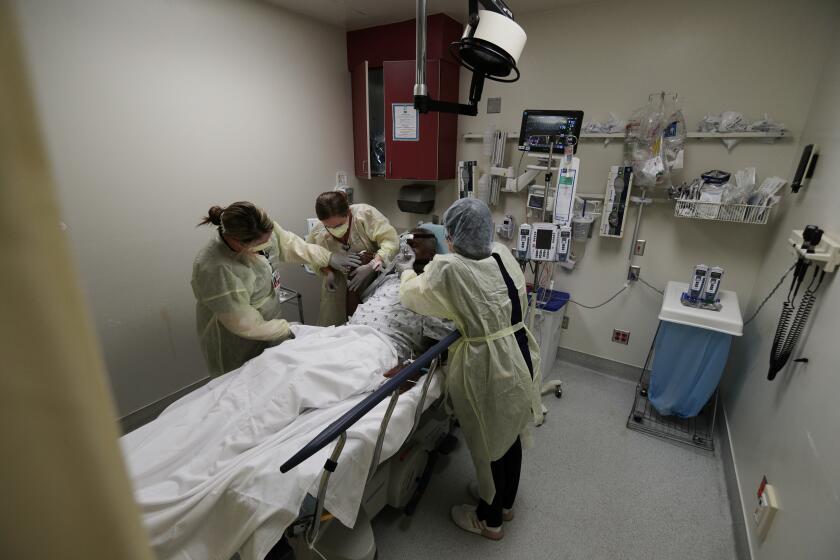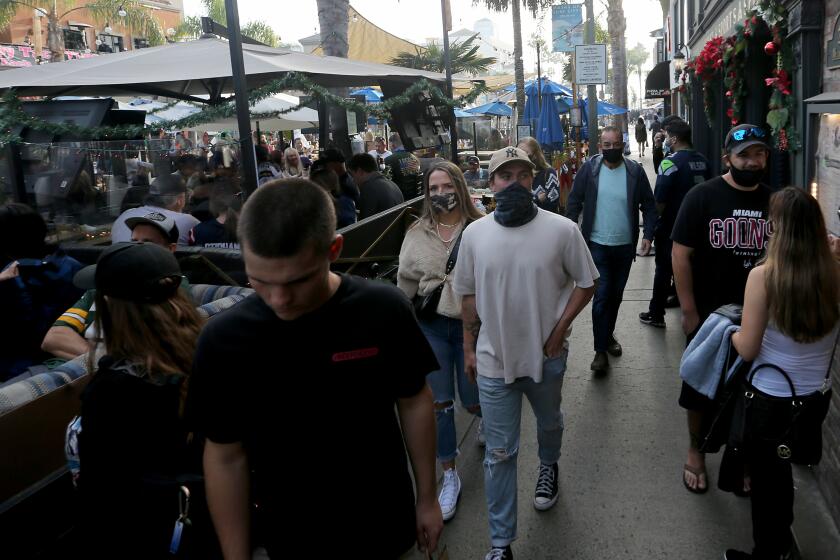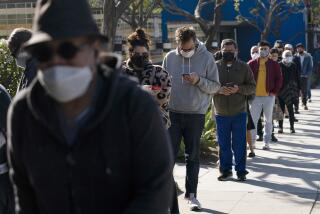‘Thanksgiving bump’ sends California to record 35,400 coronavirus cases, 219 deaths

- Share via
California on Tuesday shattered single-day records of coronavirus cases and deaths — 35,400 new infections, and 219 fatalities — by far the worst tallies of the entire pandemic.
Tuesday’s death toll edged out the previous single-day high for California, which was recorded on July 31, when 214 deaths were recorded, according to The Times’ independent county-by-county tally of cases. And Tuesday’s case count just eclipsed Monday’s record-breaking tally, 34,490 cases, which itself was stratospherically higher than any prior case count.
The latest tally means an average of 135 Californians have died each day over the last week — a number not seen since August — and nearly 25,000 people tested positive for the virus daily, a figure more than twice as bad as the peak of the summer surge.
Monday’s tally of infections marked a particularly sizable jump from any other previous daily tally.
So large was the gap between Monday’s report and the previous single-day record — set Friday, when 22,369 cases were tallied — that the difference of the two numbers, 12,121, would have ranked among California’s highest totals before the latest surge.
Gov. Gavin Newsom has announced a stay-at-home order affecting most of California.
The record-shattering report mirrors the consequences that officials had expected to see of travel and gatherings for the Thanksgiving holiday. The numbers also may foreshadow a time when daily infection counts equaling the size of a small city could be more the norm than the exception.
“I would say this is the start of the Thanksgiving bump,” Los Angeles County Public Health Director Barbara Ferrer said.
The latest increases, she said during a briefing Monday, “reflect actions we took in late November, and we can’t take those actions back. What we can do is change our actions today so that, two to three weeks from now, we’re not reporting a similarly disastrous cascade of events.”
In the coming weeks in L.A. County, hospitals will try to choreograph their staffing to best meet the needs of critically ill patients.
The rate at which coronavirus tests are confirming infection has also soared in recent weeks. California’s seven-day positivity rate is now 10.5%, the latest state data show, up from the 14-day average of 8.4%.
Officials are quick to note that cases themselves are not a byproduct of testing, because screenings merely confirm whether someone is already infected. But the ballooning case count, combined with a greater proportion of tests coming back positive, makes clear that coronavirus transmission is widespread throughout the state, experts say.
The extent of infections in California is particularly troubling because about 12% of those who test positive will fall ill enough to require hospitalizations two to three weeks later. If case counts remain high for an extended period of time, the worry is that hospitals will be inundated, stretching bed capacity and the ability for trained staff to care for the flood of new patients.
Overworked staff and overtaxed facilities threaten to erode the quality of care for everyone, not just those battling COVID-19, officials say.
“Unfortunately, we are shattering records, every day,” said Dr. Sara Cody, the health officer for Santa Clara County. “Many of our hospitals have already elected to cancel elective surgeries and other procedures in order to be able to care for the influx of COVID patients.”
There are now 10,567 coronavirus-positive patients hospitalized statewide, and 2,417 are in intensive care, state data show. Both of those figures are all-time highs.
The current number of hospitalizations has doubled in less than three weeks.
“I think everyone at this point really shares with me this deep concern about how do we make sure that people understand, if the numbers don’t start to go down ... you look at what I say are horrific scenarios that end up playing out, not just in our county, but across the state,” Ferrer said.
Those, she said, would be “where your morgue can get backed up, where you’re delaying care for people who really need care.”
Roughly 240,000 Californians have tested positive for the virus in the last 14 days, and about 112 have died of COVID-19 each day over the last week.
Given all the distressing data points seen during the recent surge, one relatively bright spot had been that the most devastating metric — the number of deaths — had remained relatively low. But that’s no longer the case.
The state has averaged 135 COVID-19 deaths a day over the last week, a rate not seen in months, according to data compiled by The Times.
Nearly 1,400 Californians have died from COVID-19 in the last 14 days, Times data show. Those deaths combined to push the state past a milestone Monday: 20,000 cumulative coronavirus-related fatalities.
It’s against this backdrop that Gov. Gavin Newsom last week unveiled a fresh round of restrictions, to be implemented when a region’s available ICU capacity drops below 15%.
The new stay-at-home order would require affected communities to limit most retail capacity to 20% and close hair salons, nail salons, public outdoor playgrounds, card rooms, museums, zoos, aquariums and wineries. Restaurants would be able to offer only takeout or delivery as indoor and outdoor dining would be banned.
“Our message is: As much as you can, stay at home,” Dr. Mark Ghaly, California’s health and human services secretary, said during a briefing Tuesday. “We know that it works. We know that we can bring our transmission rates down.”
As of Tuesday, two state-defined regions — Southern California and the San Joaquin Valley — had seen their available ICU capacities tumble low enough to trigger the order. Those restrictions took hold at 11:59 p.m. Sunday and will remain in place for at least three weeks.
Five Bay Area counties — San Francisco, Santa Clara, Contra Costa, Alameda and Marin — also announced last week that they would proactively implement the new restrictions and planned to keep them in place until at least Jan. 4.
Combined, those regions are home to some 33 million Californians, representing 84% of the state’s population.
Ghaly said all residents — even those in areas not covered under a regional stay-at-home order — should heed the call.
“Right now, we’re seeing such high levels of transmission that almost every activity — I should say every activity — that could be done differently and keep us at our home, not mixing with others, is safer,” he said. “Those are going to be the tools that help us get this under control.”
The Governor’s Office of Emergency Services sent cellphone emergency alerts emphasizing that point to residents across Southern California and the San Joaquin Valley on Tuesday afternoon.
Ghaly added that he thinks the early move on the part of some Bay Area counties is a recognition “that the sooner some of these changes go into effect, the hope is that the impact is greater and that we can shorten the time that these orders are in place.”
That’s particularly true given the lagging nature of the virus. Those who are hospitalized now were largely infected two to three weeks ago, when case counts, though high, were significantly lower than today.
“We anticipate not just the ongoing slope of increase that we’ve seen now, [but] we are [also] worried about a rapidly accelerating increase and pressure on our hospitals,” Ghaly said. “If we thought we were sort of peaking at this level, some of the regional stay-at-home orders may not have been necessary.”
Health experts say we are entering a dangerous phase of the pandemic, but restaurant owners say the economic toll poses its own existential threat.
Ghaly said earlier this week that cases stemming from “dinner tables or activities and plans, travel through Thanksgiving, are going to show up right about now,” and “we know we’ll be seeing that for many days to come.”
Ferrer reiterated that point Tuesday, telling the L.A. County Board of Supervisors that “we anticipate continuing to see these very high numbers of cases now as we’re moving into a reflection of actions people took over the Thanksgiving week.”
Though the latest numbers are painting an increasingly bleak picture of the pandemic in California, officials emphasize that everyone — residents and businesses alike — can do their part to help stymie the surge.
Taking simple steps, such as wearing a mask in public, regularly washing your hands and staying home when you’re sick, as well as keeping distance from, and avoiding gatherings with, those outside your household can all make a significant dent, experts and officials say.
There’s also hope on the horizon, as the first COVID-19 vaccines are slated to arrive in California shortly. Newsom said Monday the state was planning to receive 2.16 million doses this month — with deliveries expected to start by next week.
The goal is to vaccinate as many essential healthcare workers as possible in hopes of completing the first step of the county’s plan by January’s end.
Ferrer said L.A. County will likely get 84,000 doses of the vaccine in its first allocation from the state, possibly next week.
Health officials in Orange County said they expect to receive 25,350 doses next week.
“COVID-19 isn’t over yet,” Orange County Board of Supervisors Chairwoman Michelle Steel said in a statement Tuesday. “But this first batch of vaccines will help stop the spread of the virus.”
The priority for the initial wave of vaccines will be healthcare workers.
Though the next few weeks may be tough, it’s not too late to turn things around, Ferrer said.
“While we know we’re going to see significant increases for the next two to three weeks, it can turn itself around at the moment we all start getting back into the game,” she said Monday. “We don’t have to actually just say, ‘This is inevitable. We’re going to see an overwhelmed healthcare system.’ ... We have time, but very little, to get ourselves to a place where that will not be the case.”
Times staff writers Andrea Roberson, Jaclyn Cosgrove, Rong-Gong Lin II, Sean Greene and Soumya Karlamangla contributed to this report.
More to Read
Sign up for Essential California
The most important California stories and recommendations in your inbox every morning.
You may occasionally receive promotional content from the Los Angeles Times.




















